Courses
Click on the following links to skip to a certain section of this page:- Language Courses
- Upper-Level Courses (above HISP 108)
- Courses Also Taught by Hispanic Studies Faculty
Fall 2024 Course Listings
All schedule information is tentative. Please see the Registrar's site for the latest information.
For short video introductions to many of our courses, click on the course titles.Questions about major/minor requirements, course offerings, or studying abroad? Contact our Undergraduate Advising Head: Professor Zoila Castro.
Language Courses
For more information about HISP 10-108 placement/enrollment, please see our Language Programs Placement page. If you have any questions, please contact Prof. González Ros.
(1) M,W,Th,F 9:05–9:55 AM, Reyes de Deu
(2) M,W,Th 10:10–11:00; T 10–10:50 AM, González Ros
Prerequisite: Permission required (please see instructions on our Language Programs Placement page).
For students who have had no previous study of Spanish. An introduction to the Spanish language and culture, this course focuses on the acquisition of basic communication skills in Spanish and cultural awareness. Students will actively speak, write, listen, and read in the target language. A variety of media and texts relating to authentic familiar topics will be used. Active participation is essential.
(1) M,W,Th,F 9:05–9:55 AM, Mederos
(2) M,W,Th 10:10–11:00; F 10–10:50 AM, Mederos
(3) M,T,W,Th 11:15 AM–12:05 PM, Cobeta
Prerequisite: A grade of C- or higher in HISP 10a or the equivalent. Permission required (please see instructions on our Language Programs Placement page).
For students with some previous study of Spanish. Students will continue the development of all language skills (speaking, reading, listening, writing, and culture) using a variety of media and texts relating to authentic familiar topics. The focus of the class is to communicate effectively and to learn more about the cultures of the Spanish–speaking world. Active participation is essential.
(1) M,T,W,Th 9:05–9:55 AM, Turpin
(2) M,W,Th,F 11:15 AM–12:05 PM, Reyes de Deu
(3) M,W,Th 12:20–1:10; F 12:45–1:35 PM, Reyes de Deu
(4) M,W,Th 10:10–11:00; T 10–10:50 AM, Cobeta
(5) M,W,Th 1:20–2:10 PM; T 12:45–1:35 PM, Cobeta
(6) M,W,Th 10:10–11:00; F 10–10:50 AM, Reyes de Deu
Prerequisite: A grade of C- or higher in HISP 20b or the equivalent. Permission required (please see instructions on our Language Programs Placement page).
Students in HISP 32 will bring their proficiency up to an intermediate level. Prepares students to communicate on a variety of topics which are familiar or of personal interest. All language skills will be practiced with a special emphasis on interpersonal communication and cultural competence.
*HISP classes listed below (104 and above) are conducted in Spanish, unless otherwise noted.*
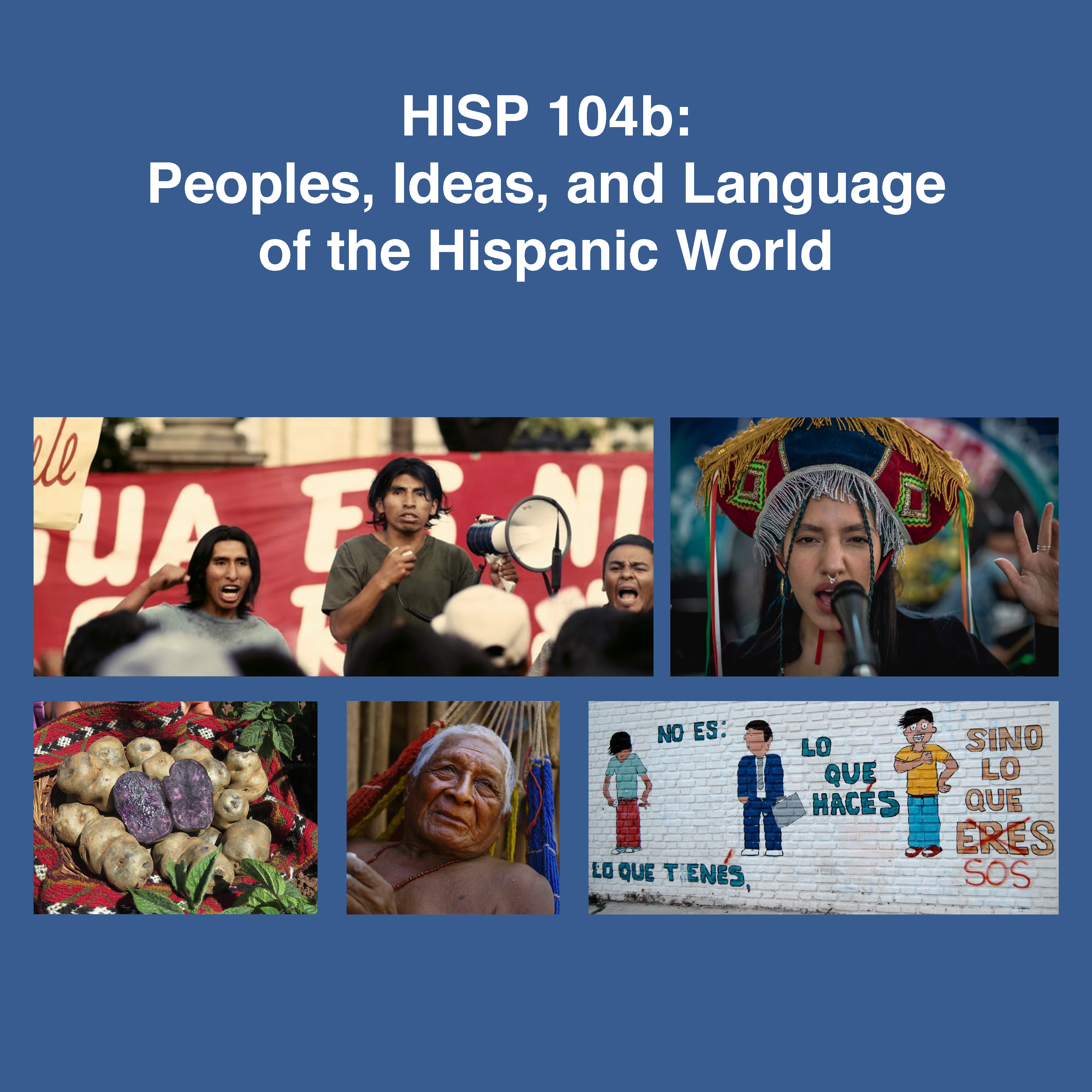
(1) M,W,Th 10:10–11:00 AM, Castro
(2) M,W,Th 11:15 AM–12:05 PM, Castro
(3) M,W,Th 12:20–1:10 PM, Mederos
Prerequisite: HISP 32 or 34. Permission required (please see instructions on our Language Programs Placement page).
Participants will expand their language skills in Spanish while deepening their understanding of Hispanic cultures. Students will explore how their identity and those of others is expressed through language, images, and cultural practices.
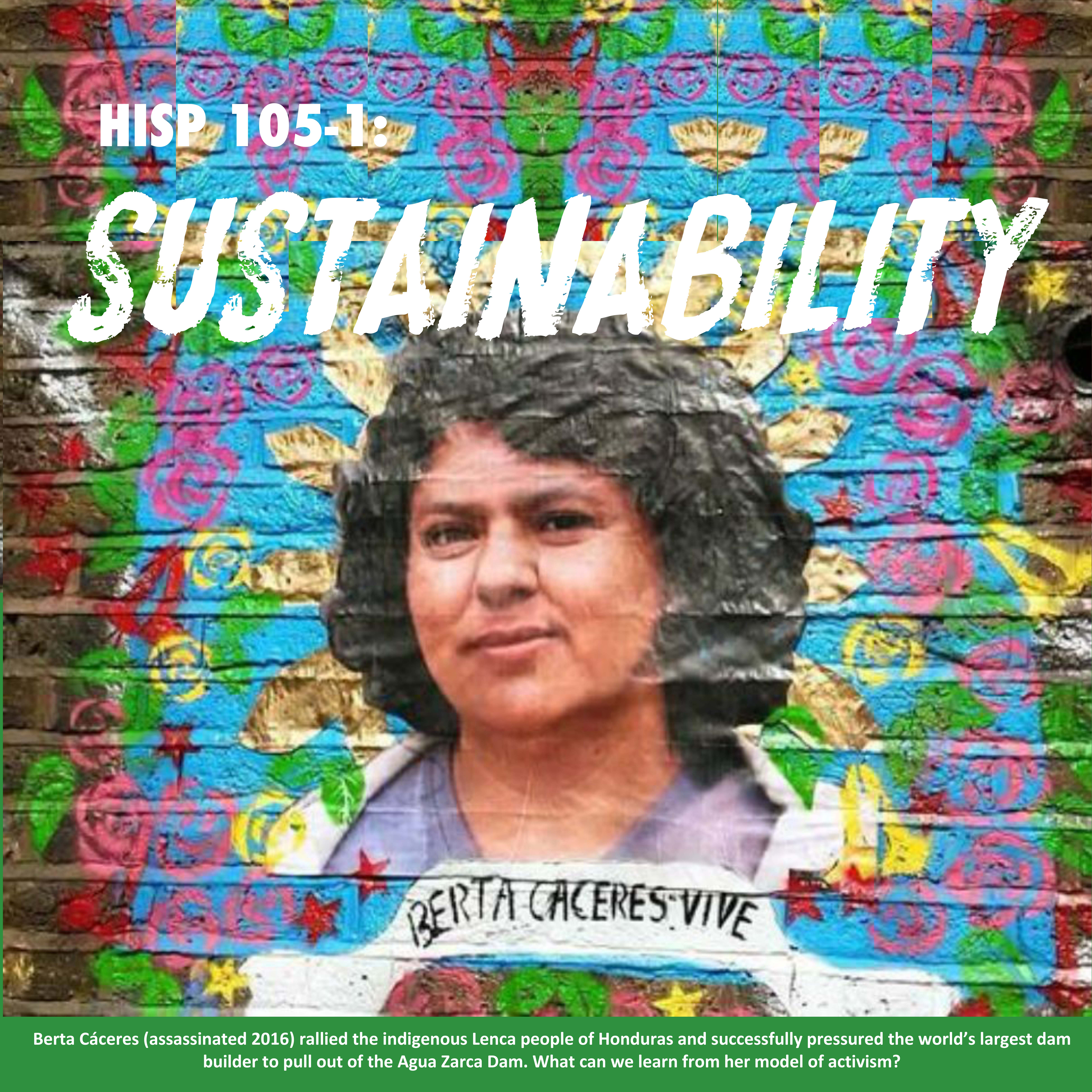
(1) M,W,Th 1:20–2:10 PM, Castro
Prerequisite: HISP 104b or the equivalent. Permission required (please see instructions on our Language Programs Placement page).
How do we persuade others to enact meaningful change? In this special topics section of Hisp 105, students will improve their speaking skills as they explore issues of sustainability in the Spanish–speaking world. We will reflect about the global consequences of individual actions, debate about the feasibility of ecotourism, and tell the stories of indigenous and Latin American climate activists.
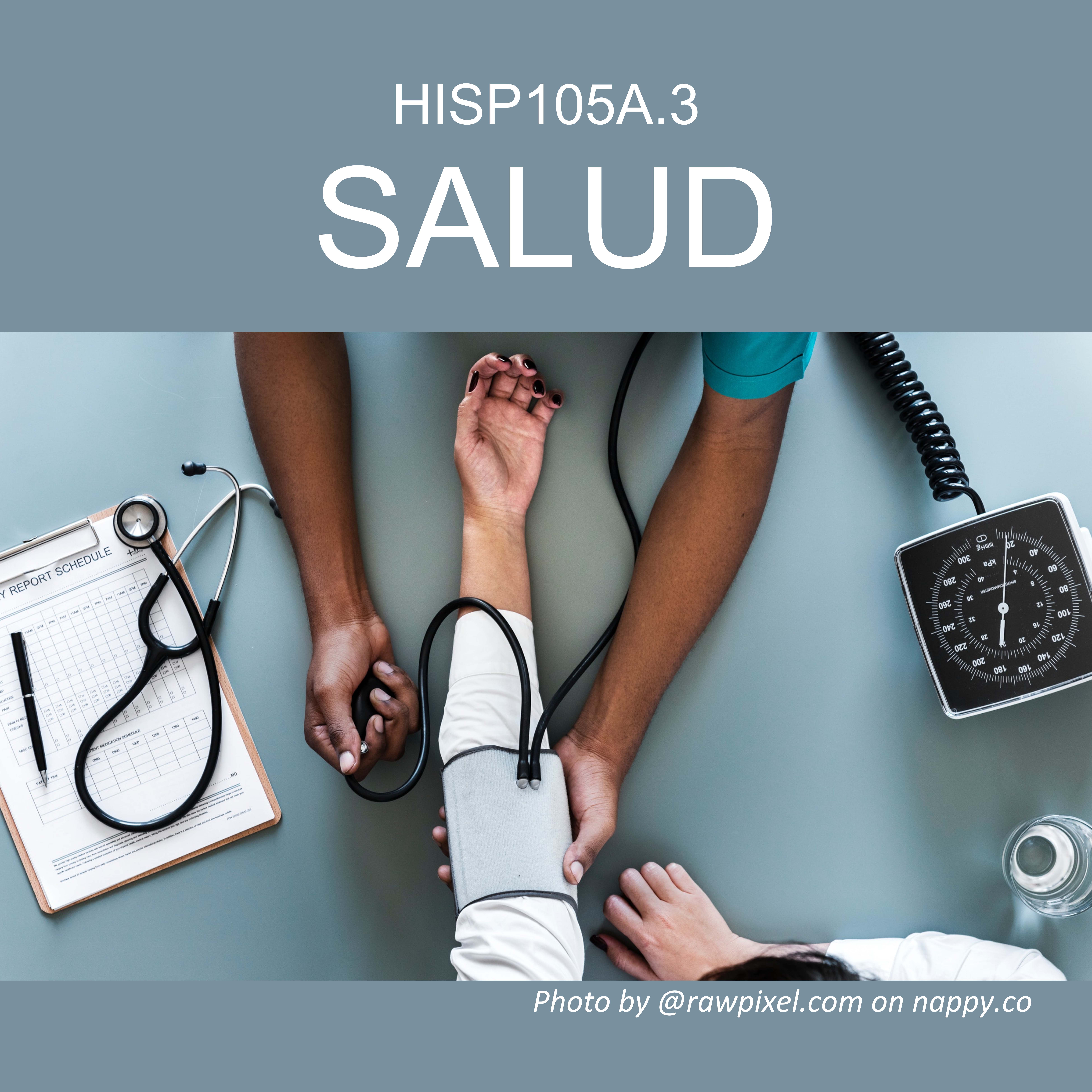
(3) M,W,Th 12:20–1:10 PM, González Ros
Prerequisite: HISP 104b or the equivalent. Permission required (please see instructions on our Language Programs Placement page).
Students will improve their oral communication skills through active participation in practical tasks in contexts related to the way the Spanish–speaking world views the concepts of health and wellbeing. Students will present information, conduct interviews, persuade and debate, among other communicative functions. This course is appropriate for students in any field where they would interact with Spanish speakers regularly.
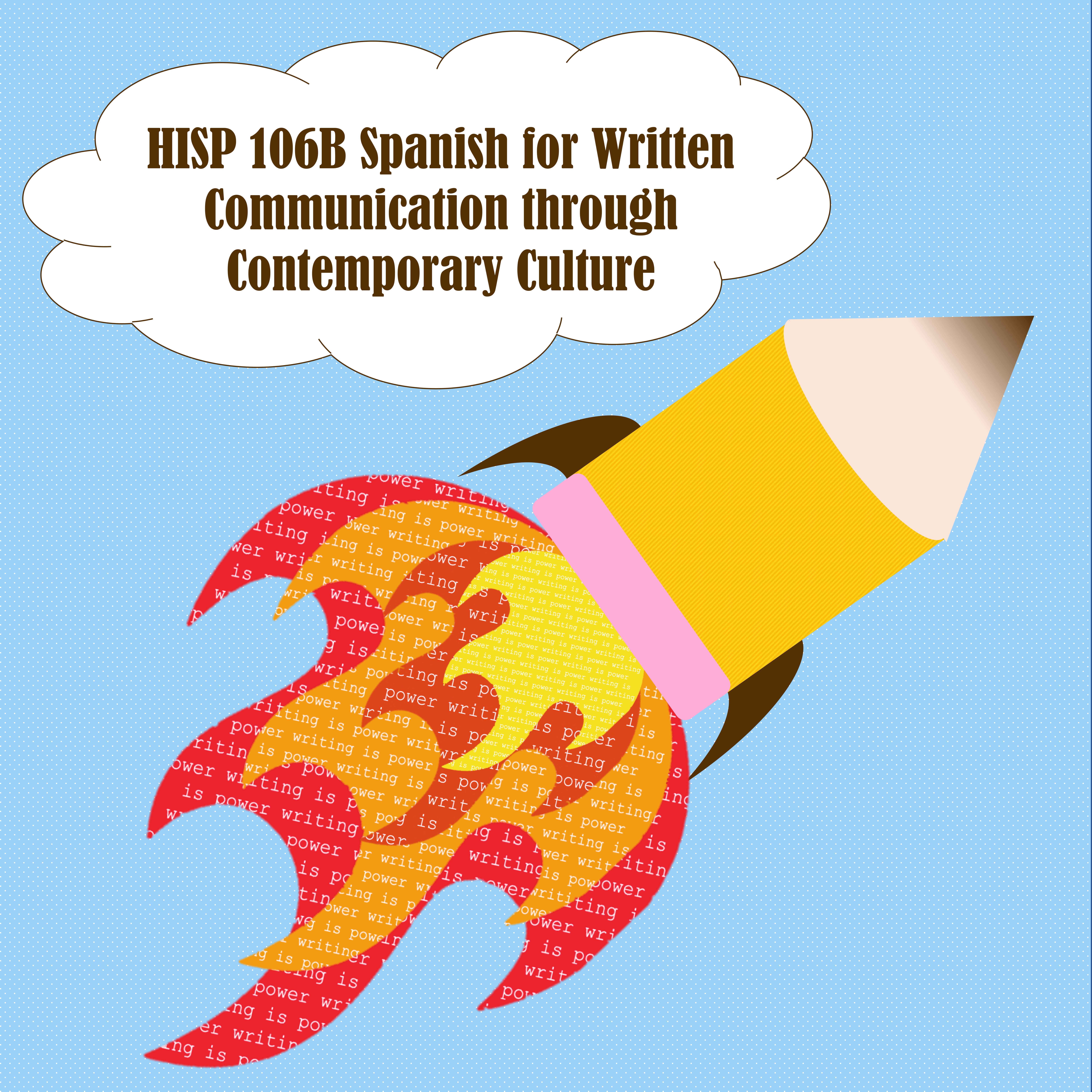
(1) T,F 11:10 AM–12:30 PM, Turpin
(2) T,F 12:45–2:05 PM, Turpin
Prerequisite: HISP 105a or the equivalent. Permission required (please see instructions on our Language Programs Placement page). [WI]
Students will develop their writing skills in order to communicate effectively in a variety of contexts and for different audiences. Examples may include creative, professional, and academic texts.
Upper-Level Courses (above HISP 108)
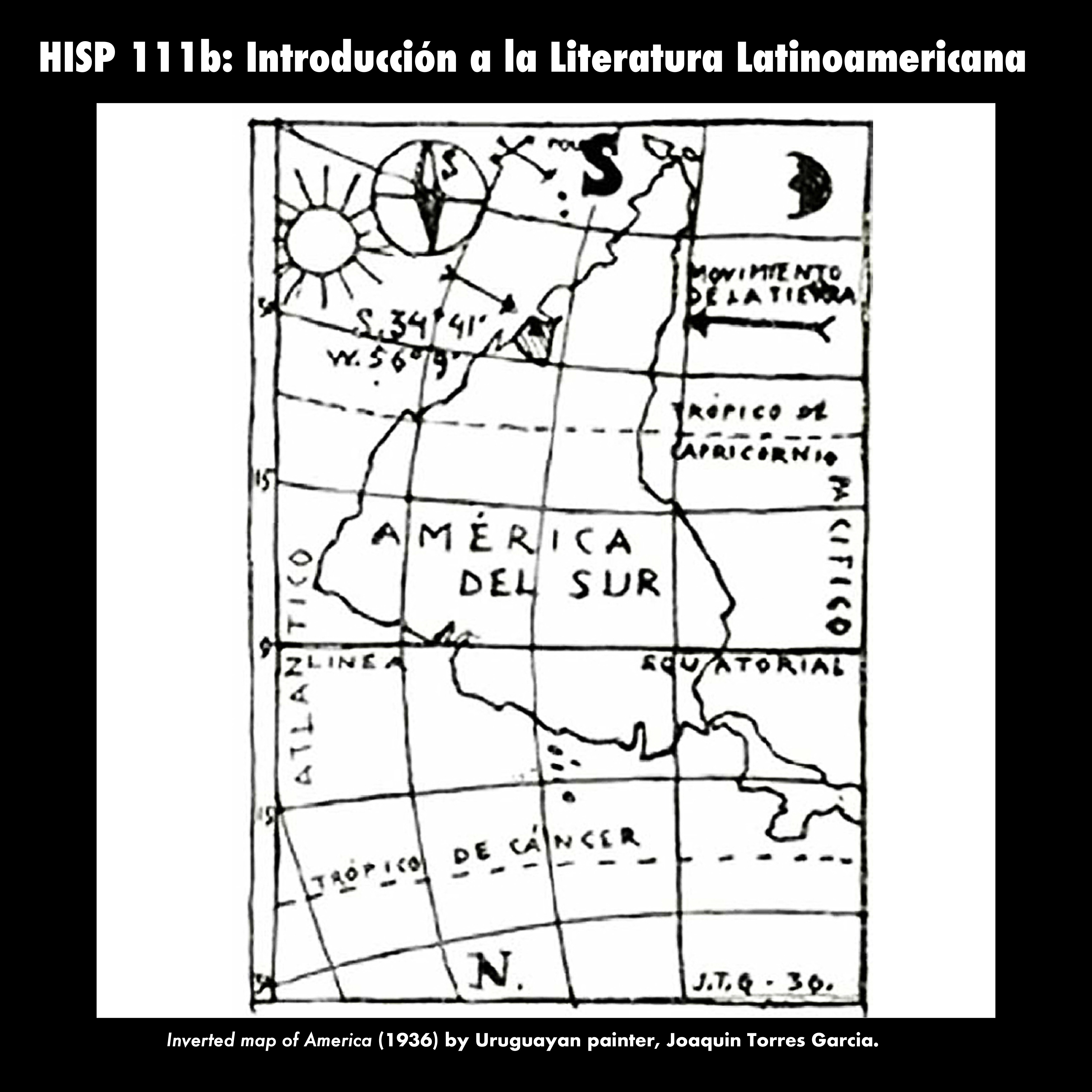
(1) T,Th 2:20–3:40 PM, Rosenberg
Taught in Spanish. Prerequisite: HISP 106b, or HISP 108a, or permission of instructor. [DJW; Cross-listed with COML, IGS, LACLS, and MUS]
Examines key Latin American texts of different genres (poems, short stories and excerpts from novels, chronicles, comics, screenplays, cyberfiction) and from different time periods from the conquest to modernity. This class places emphasis on problems of cultural definition and identity construction as they are elaborated in literary discourse. Identifying major themes (coloniality and emancipation, modernismo and modernity, indigenismo, hybridity and mestizaje, nationalisms, Pan-Americanism, etc.) we will trace continuities and ruptures throughout Latin American intellectual history.
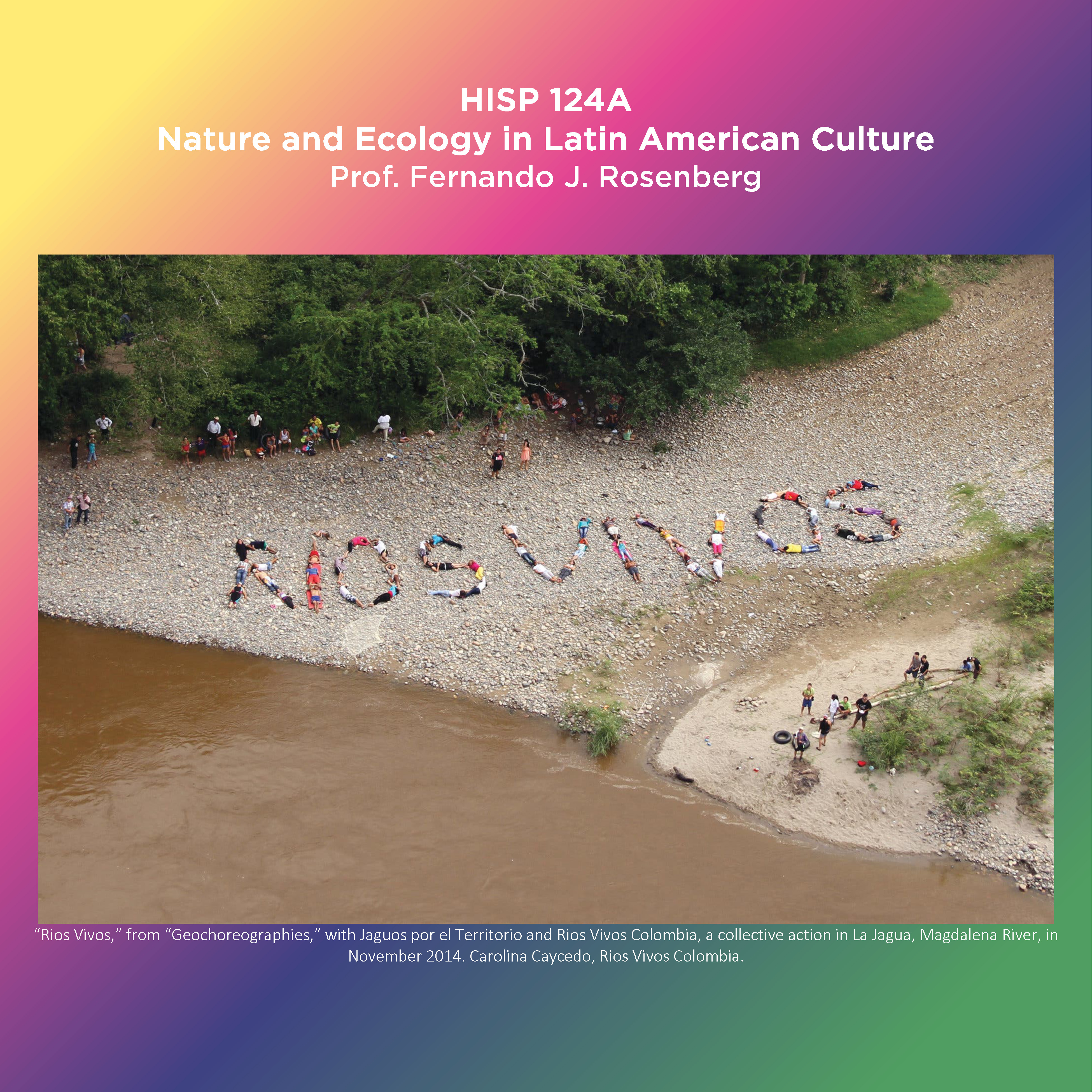
(1) T,Th 5:30–6:50 PM, Rosenberg
Prerequisite: HISP 111b or permission of the instructor. [DJW; Taught in Spanish; Cross-listed with LACLS.]
Studies the critical ecological thinking that has been central to Latin American artistic and literary production, as contemporary aesthetic practices are urging us to reconceive the relationship between human and non-human. Indeed, the Americas are an important site for these explorations, as nature was conceived in colonial and modern projects as a promise, as plentiful or exuberant, everlasting, alien albeit at humans' disposal; also as disorderly, in need of domestication, settlement, exploitation. Complimentarily, humans deemed close to nature (Indians, women, children) were considered other than human, even when nature was idealized. Artists and writers have revisited and questioned these inherited constructions along with the ways of conceiving the relationship of modern society with material conditions of planetary life--arguably the existential challenge of our times.
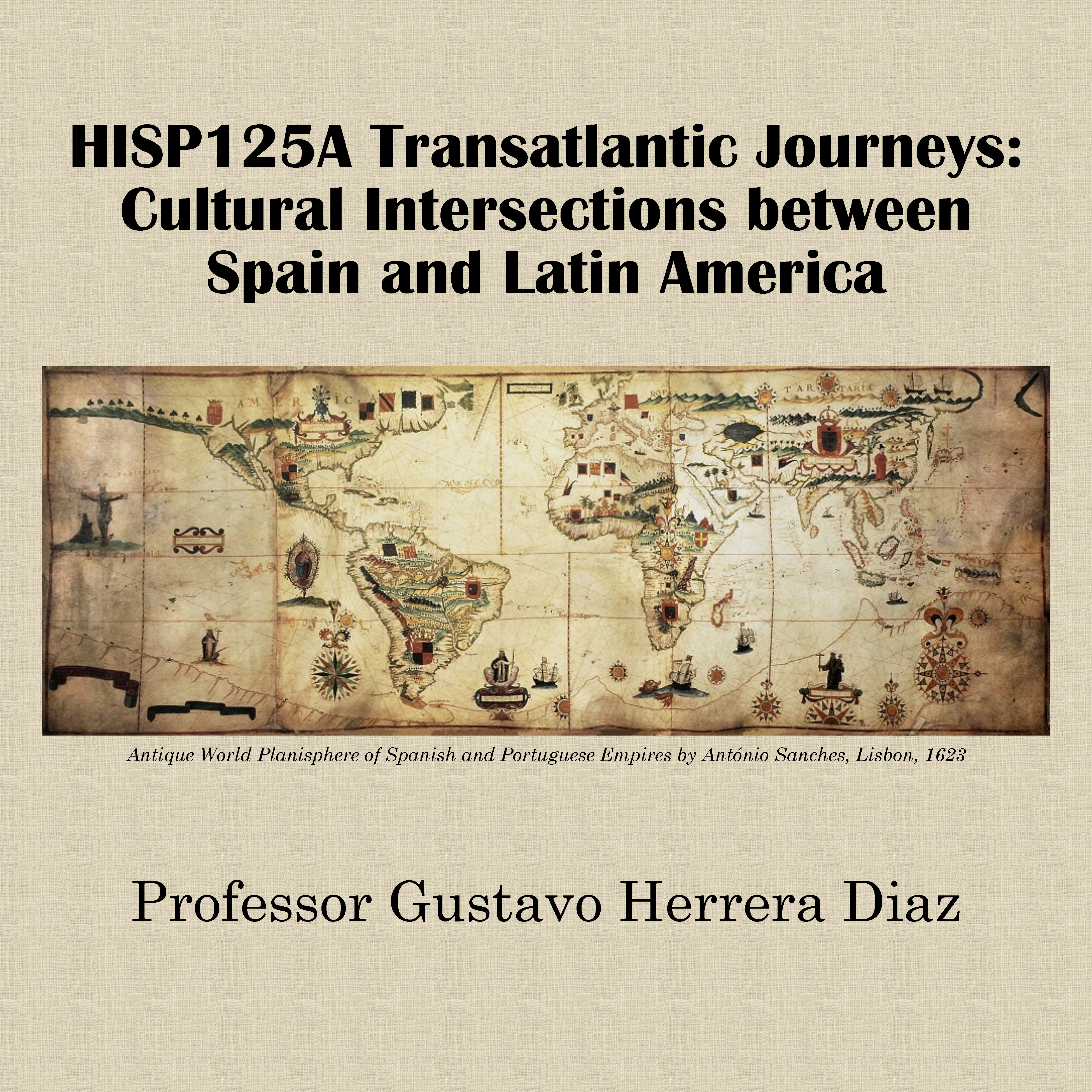
(1) M,W 4:05–5:25 PM, Herrera Díaz
Prerequisite: HISP 109b or HISP 111b, or permission of the instructor. [Cross-listed with ECS & LACLS.]
Explores the rich cultural and historical ties between Spain and Latin America from a transatlantic perspective. Emphasizing an interdisciplinary approach, it covers mutual influences, themes, and circuits of material and symbolical interchange between both territories, spanning from the era of colonization to contemporary globalization. The course places a strong emphasis on themes of myth, sorcery, and religious beliefs, with a special focus on transgressive identities such as rebels, madmen, witches, demons, and mythical creatures. It also delves into other important areas, such as the role of African and Indigenous cultures in the transatlantic colonial and postcolonial era, transnational narratives of race, processes of migration, and circuits of influence in arts and sports. Throughout the semester, students will critically analyze cultural artifacts, understand historical contexts, and engage in comparative studies to appreciate the unique and shared aspects of Spanish and Latin American cultural identities and narratives. This exploration aims to enhance their Spanish language proficiency and research skills, provide a nuanced understanding of the dynamic transatlantic exchanges that have shaped both regions, and invite discussion of past and present trends.
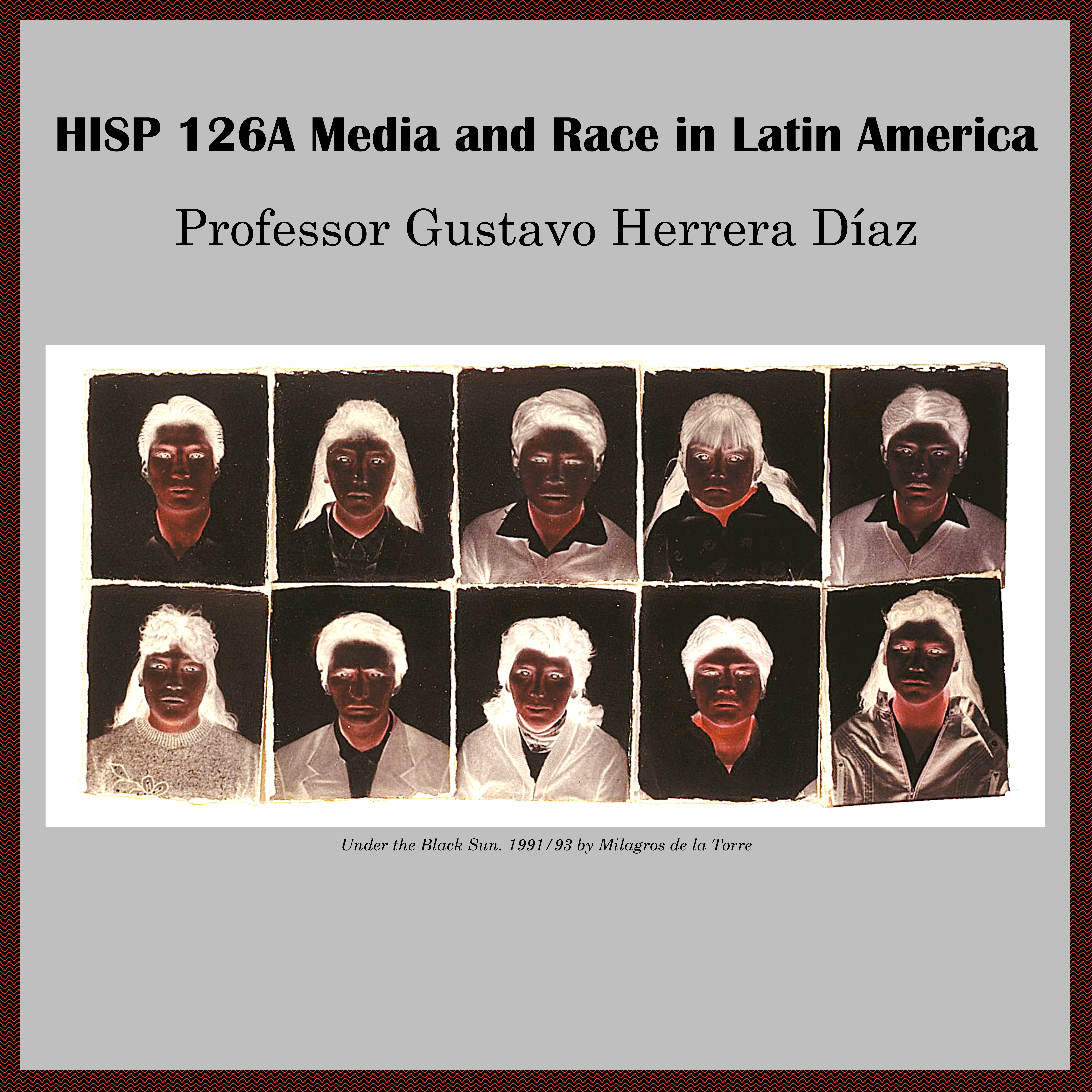
(1) M,W 2:30–3:50 PM, Herrera Díaz
Prerequisite: HISP 111b, or permission of the instructor. [Cross-listed with LACLS.]
Explores the complex interplay between race and media in Latin American culture from colonial times to the present. The course emphasizes the dual role of media as a mirror reflecting societal views and a molder shaping perceptions and attitudes toward race and ethnicity. Students will engage with a variety of materials, including literary texts, visual arts, films, music, and modern digital platforms, to understand the representation, evolution, and negotiation of racial categories across the region. Covering countries such as Brazil, Mexico, Guatemala, Cuba, Perú, Puerto Rico, the Dominican Republic, and Haiti, the course discusses how Latin American media has historically both perpetuated and challenged racial stereotypes and inequalities. Finally, the course will also examine the intersection of race and media in relation to other intersectional categories such as gender, class, and national identity.
Literature and Culture Courses (Taught in English)
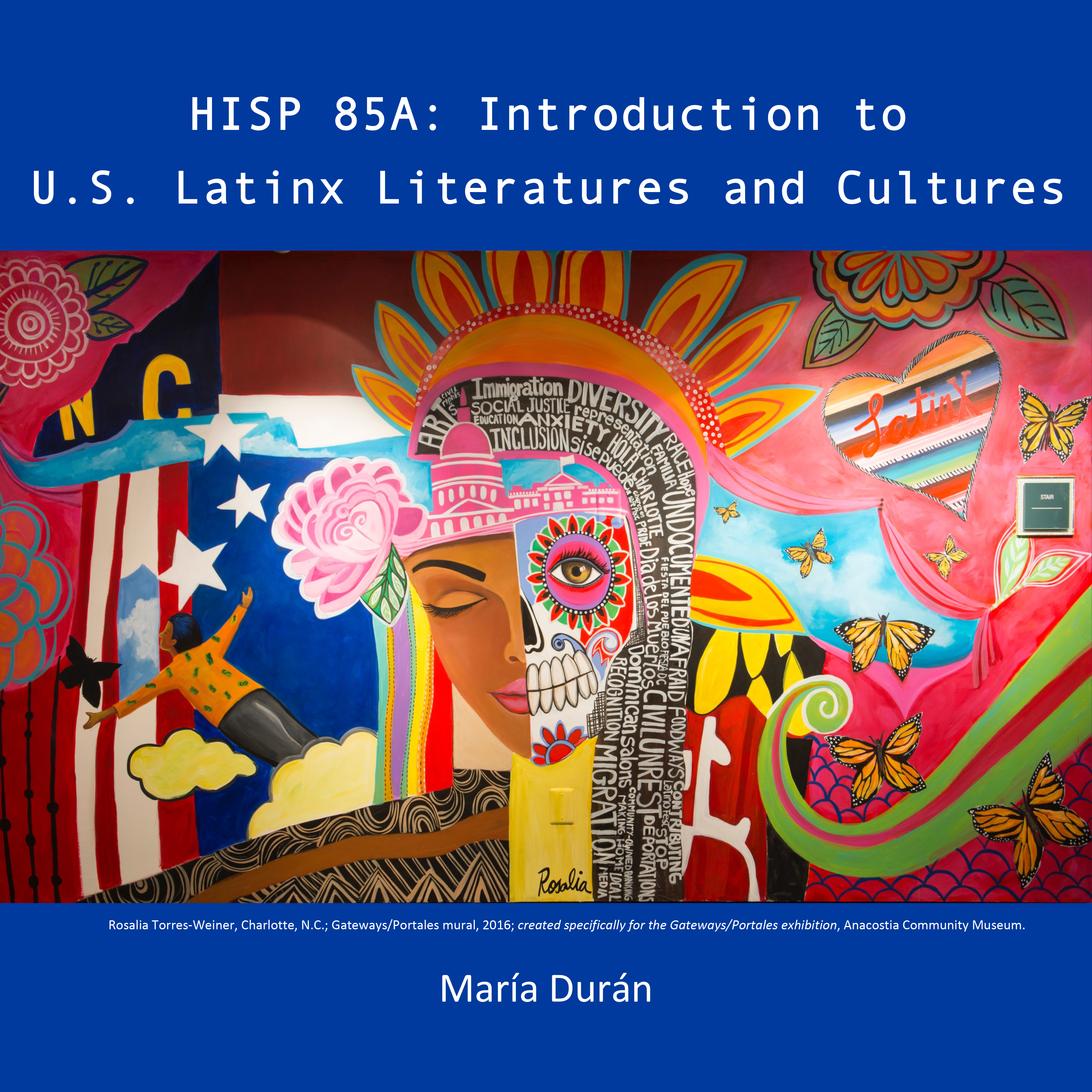
(1) T,F 11:10 AM–12:30 PM , Durán
Taught in English. [DEIS-US; DJW; DL; Cross-listed with LACLS & ENG.]
This discussion-based course introduces students to U.S. Latinx cultural productions and to the interdisciplinary questions that concern U.S. Latinx scholars, peoples, and communities. Latinxs have played a vital role in the history, politics, and cultures of the United States. U.S. Latinx literary works, in particular, have established important socio-historical and aesthetic networks that highlight Latinx expression and lived experiences, engaging with issues including biculturalism, language, citizenship, systems of value, and intersectional identity. Though the Latinx literary tradition spans more than 400 years, this course will focus on 20th and 21st century texts that decolonize nationalist approaches to Latinidades and therefore challenge existing Latinx literary “canons.”
Also Taught by Hispanic Studies Faculty:
(1) T,F 9:35–10:55 AM, Durán
Taught in English. [NW, OC, Cross-listed with IGS]
Provides a broad overview of the histories, cultures, and politics that continue to shape the Americas; specifically of the vast regions and populations of what came to be labeled as "Latin America," "the Caribbean" and what we now call "Latinx " populations in the USA. The class provides an introduction to Latin American, Caribbean and Latinx Studies. It draws from different disciplines and fields of study that compose this field, such as history, anthropology, literature, visual arts, film, political science, among other perspectives and methodologies.